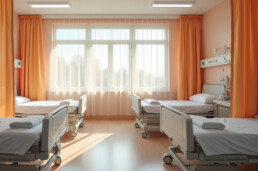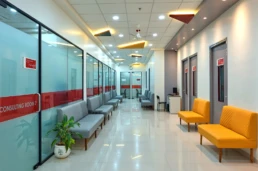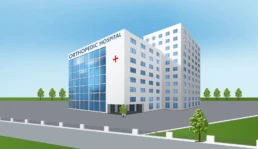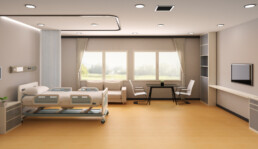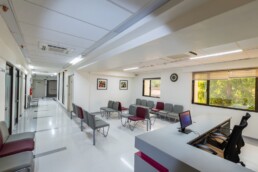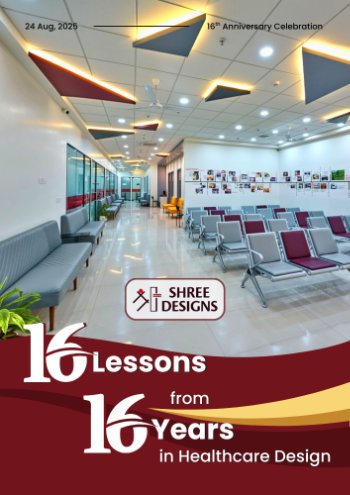Healthcare is a landscape in constant flux. New treatments, technologies, and patient needs emerge rapidly, challenging the traditional model of static healthcare facilities. The era of “build it and forget it” is over. Today, healthcare leaders must look beyond immediate needs and invest in facilities that can evolve alongside the industry.
Adaptable healthcare design is no longer a luxury; it’s a necessity. It’s about creating healthcare environments that can effortlessly adapt to changing patient populations, medical advancements, and operational requirements. By prioritizing flexibility and scalability, healthcare facilities can optimize resource utilization, enhance patient care, and future-proof their investments.
Let’s explore how adaptable design can revolutionize the way we build and operate healthcare facilities.
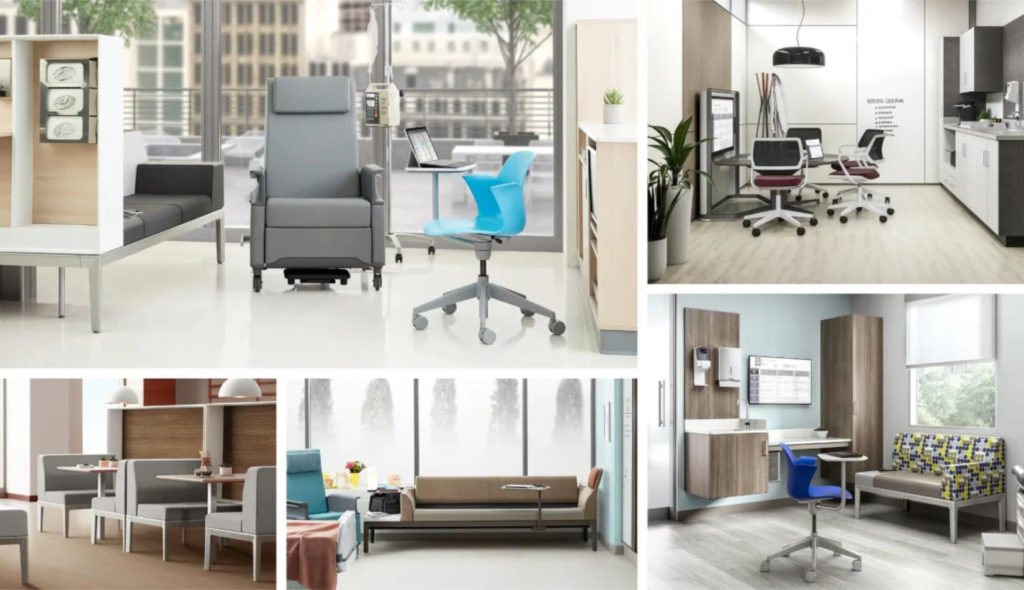
Outdated and Outpaced: The Cost of Inflexibility in Healthcare Design
Traditional healthcare facility designs often prioritized static functionality, focusing on immediate needs rather than future possibilities. These rigid structures have become increasingly inadequate in accommodating the dynamic nature of modern healthcare. For instance, the rise of telemedicine has necessitated the creation of dedicated spaces for virtual consultations, while the emergence of specialized treatments like robotic surgery requires specific infrastructure.
“Outdated, inflexible healthcare facilities are a recipe for disaster. Wasted space, poor ventilation, and capacity constraints translate directly into higher operational costs and compromised patient care,”
Consider a dermatology clinic primarily focused on clinical treatments. As the demand for aesthetic procedures grows, the clinic may find itself unable to accommodate the specialized equipment and patient flow required for these services. Without adaptable spaces, the clinic risks losing potential revenue and patient satisfaction.
Learn how to balance cost-effectiveness with adaptability in your healthcare project. Read our guide on Budgeting Tips for Healthcare Architecture and Design.
Key Principles of Adaptable Healthcare Design
A. Modular Design
Modular design involves constructing a building from prefabricated components that can be easily assembled, reconfigured, or replaced. This includes:
- Standardization: Developing consistent module sizes and configurations streamlines planning and construction.
- Interconnectivity: Designing modules with versatile connections allows for seamless integration and reconfiguration.
- Infrastructure Integration: Ensuring each module contains essential utilities (electricity, plumbing, HVAC) promotes independence and flexibility.
- Prefabrication: Maximizing prefabricated components accelerates construction and reduces on-site labor.
Real-world Applications:
- Modular operating rooms that can be added or removed as surgical volume changes.
- For example: Skåne University Hospital in Sweden faced a pressing need for additional orthopaedic operating rooms amidst a major renovation. A modular operating room complex was swiftly installed to bridge this gap. This solution demonstrated the speed, flexibility, and precision of modular construction.
- Temporary modular intensive care units for handling patient surges during epidemics, or modular outpatient clinics that can be relocated to underserved areas.
For example: China’s Huoshenshan Hospital stands as a testament to the speed and efficiency of modular construction. Erected in just ten days to combat the COVID-19 outbreak, this 1,000-bed facility demonstrated the ability of prefabricated components to be rapidly assembled into a fully functional hospital.
Discover how healthcare design can help mitigate unexpected challenges. Explore our insights on Overcoming Unexpected Challenges in Hospital Design.
B. Future-Proofing Infrastructure
To ensure a healthcare facility can adapt to future needs, investing in forward-thinking infrastructure is paramount. This includes:
- Redundancy: Incorporating backup systems (generators, HVAC units) safeguards against disruptions.
- Scalability: Designing systems with capacity to handle increased loads accommodates growth.
- Flexibility: Creating adaptable spaces and infrastructure allows for easy equipment and workflow changes.
- Technology Integration: Installing robust data networks and power outlets supports advanced technology.
- HVAC: Implementing flexible HVAC systems with modular controls enables adjustments for different room types and occupancy.
- Electrical: Designing electrical systems with ample power outlets and circuit capacity accommodates equipment changes.
- Plumbing: Creating plumbing systems with adaptable layouts and fittings simplifies future modifications.
- Data and Communications: Installing high-speed fiber optic cables and wireless infrastructure supports technology integration.
C. Multi-Functional Spaces
Designing spaces that can serve multiple purposes maximizes space utilization and reduces the need for costly renovations. These ensure:
- Flexibility: Incorporating movable walls, partitions, and furniture allows for space reconfiguration.
- Equipment Accommodation: Designing spaces to accommodate various medical equipment without major alterations.
- Infrastructure Support: Providing adequate electrical, plumbing, and ventilation for multiple uses.
- Technology Integration: Ensuring spaces are equipped with data and power outlets for various equipment.
Examples of Multi-Functional Spaces:
- Examination rooms that can convert into telemedicine hubs or minor procedure rooms.
- Patient rooms adaptable for intensive care, isolation, or general care.
- Public areas that can serve as waiting rooms, event spaces, or retail areas.
From modular construction to multi-functional spaces, the principles of adaptable design offer a roadmap to creating healthcare environments that can thrive in an ever-changing landscape.
At Shree Designs, we specialize in creating healthcare spaces that are not only functional but also future-ready. Our team of experts can help you navigate the complexities of adaptable design and transform your vision into reality.
Contact us today to discuss your healthcare project and explore how adaptable design can benefit your facility.
Related Posts
Designing Healthcare Facilities
The Science of Hospital Windows
Windows in hospitals do far more than bring in light; they influence recovery rates, infection…
Designing Healthcare Facilities,Infographic
How Design Impacts Patient Care
Ever wondered what goes into designing a hospital or clinic that truly works - for doctors, staff,…
Designing Healthcare Facilities
Textures in Healthcare Spaces
When designing hospitals or clinics, texture is often seen as a “finishing touch.” At Shree…
Infographic,Designing Healthcare Facilities
The Lifecycle of a Healthcare Facility Design
Ever wondered what goes into designing a hospital or clinic that actually works - clinically,…
Designing Healthcare Facilities
Designing NABH-Compliant Hospital Interiors
A well-designed hospital isn’t just about aesthetics. From fire safety and infection control to…
Designing Healthcare Facilities,Infographic
Blueprint for Healthcare Design
From room dimensions to lighting levels, every detail matters in healthcare design. At Shree…
Designing Healthcare Facilities
Building Better Day Surgery Centres
Efficient care, happier patients, and smarter workflows - this is what defines a successful…
Project Management,Designing Healthcare Facilities,Infographic
Designing Healthcare Spaces That Truly Heal
From concept to completion, every medical space we design prioritizes patient flow, staff…
Designing Healthcare Facilities
The Business of Wellness
In the $1.8 trillion wellness industry, first impressions matter. Patients don’t just choose a…
Designing Healthcare Facilities
Efficient Hospital and Clinic Design
India’s emerging cities are growing rapidly, creating an urgent demand for accessible and efficient…
Designing Healthcare Facilities
Creating Calming and Confidential Spaces for Fertility Clinics
As the demand for fertility treatments grows, the architecture of these clinics plays a vital role…
Designing Healthcare Facilities
Designing the Perfect Hospital Pharmacy
Hospital pharmacies are the backbone of seamless patient care. From efficient workflows to secure…
Designing Healthcare Facilities
Preventive Care Facility Design Strategies
With preventive care emerging as the future of healthcare, this post outlines key architectural…
Designing Healthcare Facilities
Thermal Comfort Decoded
Thermal comfort plays a critical role in patient recovery, staff productivity, and overall…
Designing Healthcare Facilities
Designing Single Speciality Healthcare Centres
As single-speciality centres grow, their design needs become more specific, calling for tailored…
Designing Healthcare Facilities
Innovative Design Solutions for Senior Care Facilities
Designing senior-friendly spaces in healthcare facilities is crucial for catering to the evolving…
Designing Healthcare Facilities
Designing a Dental Clinic for Success
Providing quality dental care is not just about the technical elements of the treatment. It's also…
Designing Healthcare Facilities
3 Essential Design Features for Intensive Care Units
ICUs are not just limited to single units housing all critical patients. If the facility has…
Designing Healthcare Facilities
3 Lessons Learned While Building a Cardiac Cath Lab
Cardiac care design is moving at the sound of a new beat! The number of Cath labs in India has…
Designing Healthcare Facilities
5 Essential Elements of Healthcare Design
Design makes a significant impact on the delivery of care for both healthcare providers and…
Designing Healthcare Facilities
5 Best Ways to Create Healing Spaces for Kids
Designing spaces in healthcare facilities tailor-made for children is a lesson in balance! A…
Designing Healthcare Facilities
Top 5 Trends in Healthcare Design
Design can make all the difference when it comes to improving patient care. From a patient’s point…
Designing Healthcare Facilities
The Architectural Design of Hospital Facilities
Shree Designs designed and executed many efficient and safe healthcare setups in the middle of the…
Designing Healthcare Facilities
Dauntless Designers
Healthcare Radius in its 7th Anniversary Special issue in October 2019, featured a "power list of…
Designing Healthcare Facilities
The changing face of healthcare design
After completing a decade in designing healthcare projects, Kshititi Nagarkar, principal architect,…
Designing Healthcare Facilities
Thumb Rules for Planning and Designing of Hospitals
Traditional rules of thumb in healthcare planning have changed. Once-accepted rules can now be the…
